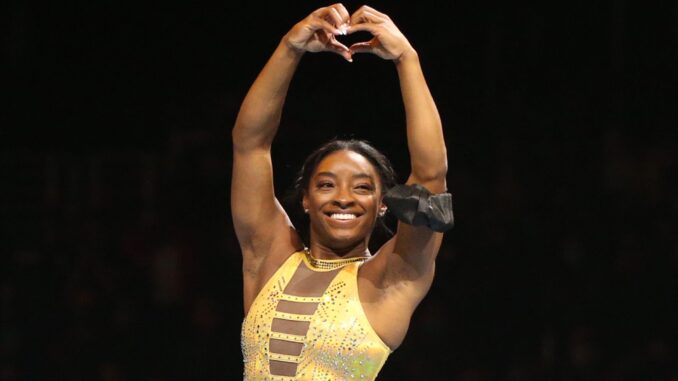
Simone Biles is getting candid about her plastic surgery experiences. The 11-time Olympic medalist casually shared in a recent TikTok that she’s had three plastic surgeries, including two that people wouldn’t notice. While the 28-year-old was coy in the video about what she’s had done, she later told People that she’s had breast augmentation, surgery to fix a tear in her ear, and a blepharoplasty (a.k.a. “bleph”), which is a surgical procedure done on the eyelids.
“I got a lower bleph because me and my family have, I call it the ‘Biles eye bags,’” she said. “We’ve just always had them, hereditary, and so that was just a big flaw. Every time I would go to a shoot, they’re like, ‘Oh, can we put some strips on her?’” Biles joked that she would get comments about her eyes, even when she had 12 hours of sleep the night before. “These are just hereditary, so it’s something that I wanted to fix,” she said. While most people are familiar with breast augmentation, blepharoplasty isn’t a term everyone knows. What’s the deal with this surgery? We tapped three doctors who perform it for details.
Why Simone Biles’ Eyelid Surgery Is a Big Deal
When an Olympic legend like Simone Biles talks openly about getting eyelid surgery (blepharoplasty), it naturally grabs headlines. Her decision is more than just about aesthetics — it’s a conversation starter that raises important questions for anyone thinking about cosmetic surgery. If you’re curious about exactly what she did, why she did it, and whether you should follow in her footsteps, you’re in the right place.
What Really Happened: Simone Biles Speaks Out
Simone Biles recently revealed that she underwent eyelid surgery, admitting it’s a personal decision she made for her own confidence. She’s embraced sharing her journey as part of a broader conversation about self-image, mental health, and the pressures of fame. This transparency broke down barriers — especially for people of color considering cosmetic procedures.
Why Simone Biles Might Have Chosen Eyelid Surgery
-
Confidence and Aesthetic Goals: For many, eyelid surgery is about wanting a refreshed, more alert look.
-
Professional Pressure: As a public figure, Simone’s appearance is constantly under the spotlight, and any small change can feel magnified.
-
Long-Term Decision: Unlike a whim cosmetic tweak, eyelid surgery tends to provide long-lasting results, which may have appealed to her.
What Is Eyelid Surgery (Blepharoplasty)?
At its core, blepharoplasty (eyelid surgery) is a cosmetic procedure designed to improve the appearance of the eyelids. It can involve:
-
Removing or repositioning excess skin
-
Trimming or reshaping fatty tissue
-
Tightening underlying muscles
-
Correcting droopy eyelids that may impair vision
Types of Eyelid Surgery
-
Upper Blepharoplasty — Targets the upper eyelids, addressing sagging or drooping that gives a tired or aged appearance.
-
Lower Blepharoplasty — Focuses on the lower lids to remove or reposition fat pads (“eye bags”) and reduce puffiness.
-
Combination Blepharoplasty — Involves both upper and lower eyelids for a more comprehensive look.
-
Ptosis Repair — Corrects droopy eyelids caused by weak muscles, sometimes done in conjunction with blepharoplasty.
Benefits of Eyelid Surgery
-
Youthful, alert appearance: It can make you look more awake and rejuvenated.
-
Improved vision: In cases where droopy eyelids block parts of your field of vision, surgery can help.
-
Boosted self-confidence: Feeling like your outer self matches how you feel inside is a powerful confidence boost.
-
Long-lasting results: Unlike many non-surgical treatments, results from eyelid surgery can last for years.
Risks and Complications You Need to Consider
Like any surgical procedure, eyelid surgery comes with risks:
-
Bleeding and bruising: Common right after surgery.
-
Infection: Always a risk with incisions.
-
Dry eyes or irritation: Because eyelids are delicate, some people feel dryness or discomfort.
-
Scarring: Though incisions are often hidden in natural eyelid creases, scarring is still possible.
-
Asymmetry: One eye might heal differently, leading to uneven results.
-
Vision issues: Rarely, temporary blurred vision or even more serious complications can occur.
-
Need for revision surgery: Sometimes, a follow-up procedure is needed if results aren’t satisfying.
How Much Does Eyelid Surgery Cost?
The cost of blepharoplasty varies widely depending on:
-
Geographic location
-
Surgeon’s experience
-
Facility fees
-
Whether it’s upper, lower, or both eyelids
-
Pre- and post-operative care costs
On average, in the U.S., it can range from $3,000 to $7,000 or more. But prices differ dramatically in other countries, so it’s critical to do your homework.
Recovery: What to Expect After Eyelid Surgery
-
First few days: Expect swelling, bruising, and some discomfort. Cold compresses help.
-
Week 1: Most people start feeling more comfortable. Sutures may be removed, depending on the technique.
-
Week 2–3: Bruising fades, and swelling subsides. You’ll likely start seeing the more refined shape.
-
Months 1–3: Healing continues beneath the surface. Final results really begin to settle in.
-
Long-term: Scars fade into natural creases and become nearly invisible for most.
Are You a Good Candidate for Eyelid Surgery?
You might be a suitable candidate if:
-
You’re in good overall health (no major medical issues)
-
You have realistic expectations
-
You’re bothered by droopy lids, puffiness, or vision obstruction
-
You don’t smoke (smoking slows healing)
-
You can take time off to recover

Red Flags to Watch Before You Commit
-
A surgeon who pushes for surgery without fully discussing your goals
-
A clinic that seems to cut corners or doesn’t have proper accreditation
-
Unrealistic promises or “guaranteed” outcomes
-
A lack of before-and-after photos or patient testimonials
-
No conversation about risks, or minimal discussion of recovery
How to Choose the Right Surgeon
-
Verify qualifications: Make sure they’re board-certified in plastic surgery or ophthalmology.
-
Ask for experience: Have they done eyelid surgery specifically? How many?
-
Request before-and-after photos: Ask to see patients with similar eyelid issues.
-
Read reviews: What are former patients saying?
-
Consultation matters: During your consultation, your surgeon should listen carefully and customize the plan based on you.
-
Discuss costs in detail: Don’t forget to ask about hidden fees, follow-up visits, and post-op care.
Simone Biles’ Eyelid Surgery: What We Can Learn
-
Breaking the stigma: Simone’s openness helps destigmatize cosmetic surgery — especially for athletes or people of color.
-
Empowerment through choice: She reminds us that changing your appearance can come from a place of self-love, not insecurity.
-
Transparency matters: Her honesty about the process encourages others to research, ask questions, and make informed decisions.
Alternatives to Surgery: Other Ways to Rejuvenate Your Eyes
If the thought of surgery scares you, consider non-surgical routes first:
-
Injectable treatments like Botox or fillers can soften wrinkles or hollowness.
-
Laser resurfacing can tighten skin and improve texture.
-
Radiofrequency therapy helps firm skin around the eyes.
-
Good skincare habits, including sunscreen and gentle eye creams, can go a long way.
How to Prepare Mentally and Emotionally
-
Set realistic expectations: You may look “better,” but you won’t necessarily become someone else.
-
Talk it out: Share your thoughts and fears with a trusted friend or therapist.
-
Plan for downtime: Make sure you have support and realistic plans for recovery.
-
Visualize your “why”: Why do you want this? Confidence? Functionality? Clearing that up helps you set motivated but grounded goals.
The Social and Cultural Conversation Around Celebrity Cosmetic Surgery
Simone’s surgery has sparked broader cultural conversations:
-
Body autonomy and self-expression — her decision reinforces personal agency.
-
Representation in beauty standards — as a Black Olympic champion, her transparency challenges narrow ideas about who “gets” to alter their appearance.
-
Mental health and fame — using one’s platform to normalize self-care choices can destigmatize mental health struggles.
-
Influence on younger generations — her voice may encourage others to make thoughtful, informed decisions rather than chase trends blindly.
Common Misconceptions About Eyelid Surgery
-
“It’s just cosmetic, not functional.” — Not always true. For many, sagging lids impair vision.
-
“Recovery is forever.” — While healing takes time, major discomfort eases within days to weeks.
-
“Only rich people do it.” — Costs vary, and many people finance or plan carefully for it.
-
“Surgeons guarantee perfection.” — No reputable surgeon promises a “perfect” result; risks always exist.
Tips for a Successful Outcome
-
Follow pre-op instructions closely (no smoking, no blood-thinning meds unless cleared).
-
Stay hydrated and eat healthily to support healing.
-
Stick strictly to your surgeon’s after-care plan (cleaning, ointments, sleep position).
-
Avoid strenuous activities until your surgeon says it’s safe.
-
Attend all follow-up appointments to catch complications early.
Conclusion
Simone Biles’ candid revelation about her eyelid surgery does more than make tabloid news — it opens up a meaningful conversation about self-image, empowerment, and the evolving relationship we all have with cosmetic enhancements. If you’re considering eyelid surgery, let her story be both inspiration and a reminder: this is a deeply personal decision. Educate yourself, weigh the risks and benefits, find a trustworthy surgeon, and go into the process fully informed — not just chasing a trend, but making a choice that feels right for you.
